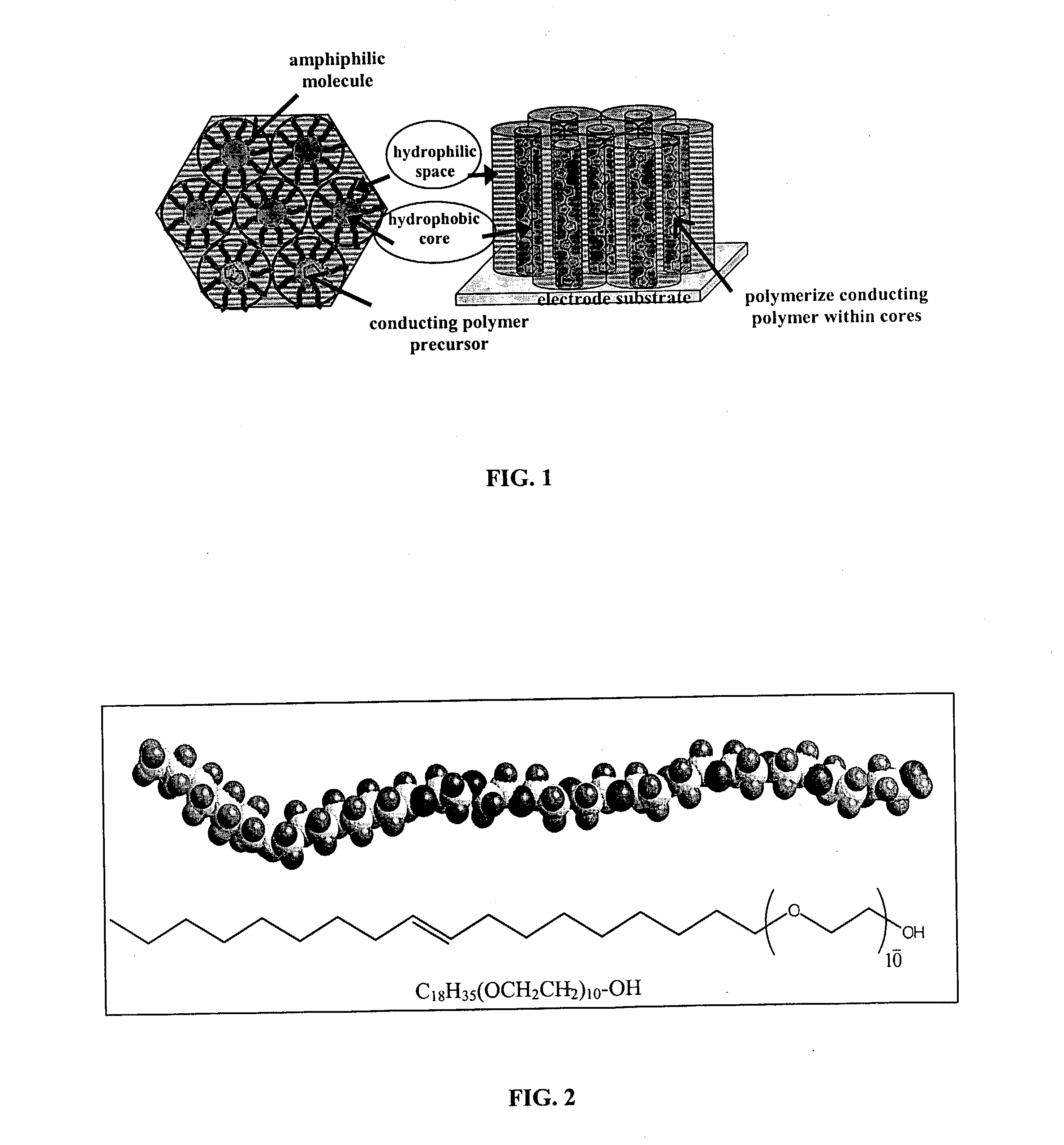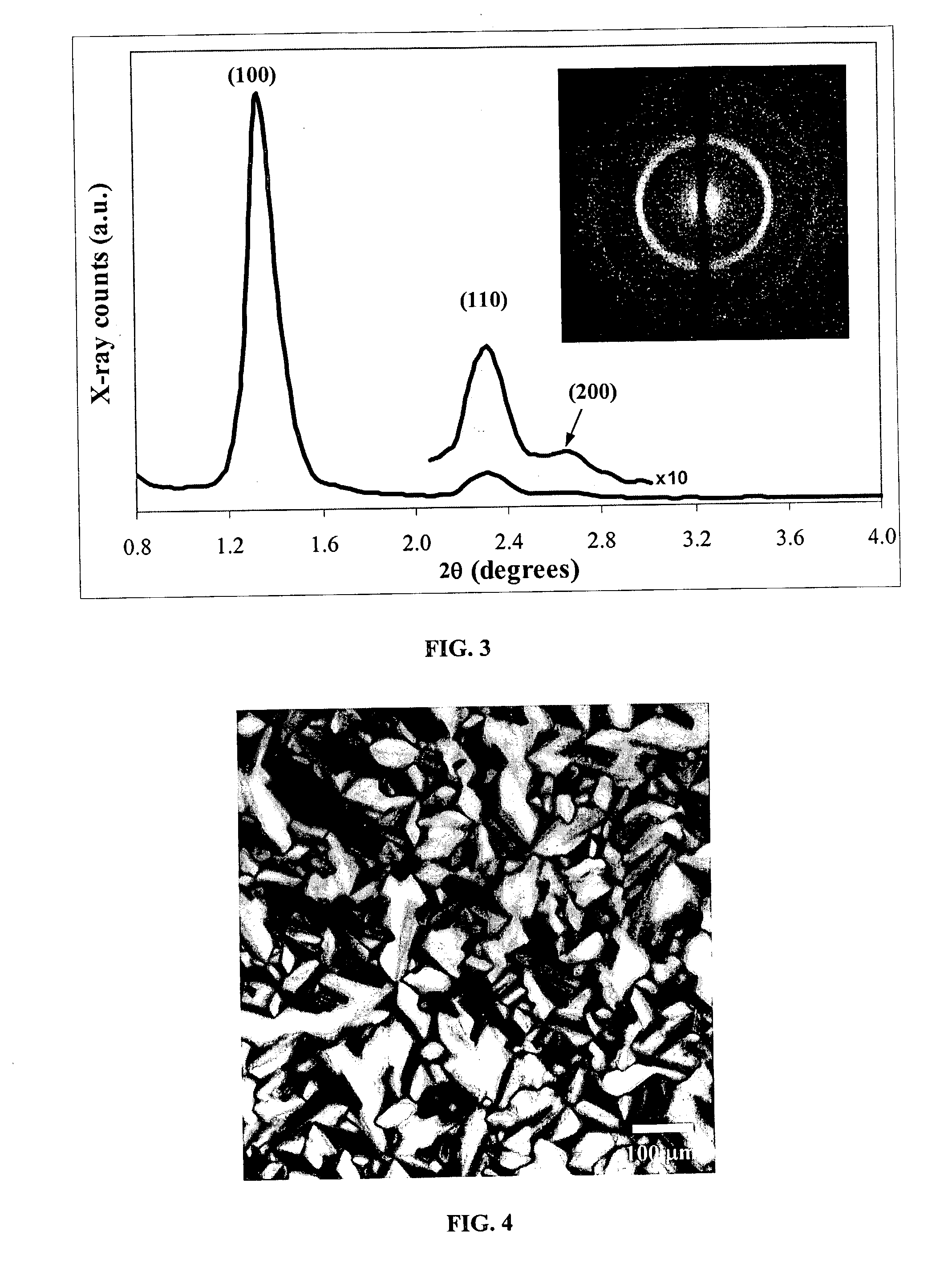Liquid crystal-templated conducting organic polymers
a conducting organic polymer and liquid crystal technology, applied in the direction of organic conductors, non-metal conductors, coatings, etc., can solve the problem that the templating via mesoporous silica is limited to soluble polymers
- Summary
- Abstract
- Description
- Claims
- Application Information
AI Technical Summary
Benefits of technology
Problems solved by technology
Method used
Image
Examples
example 1
[0039] As mentioned above, an amphiphile developed for liquid crystal templating is the nonionic surfactant poly(oxyethylene).sub.10-oleyl ether (Aldrich), abbreviated (EO).sub.10-oleyl, shown in FIG. 2. Concentrations between 45-60 wt. % in water can form a self-supporting gel of a lyotropic liquid crystal with a hexagonal mesophase. This particular amphiphile, illustrative of other compositions useful with the present invention, was chosen due to its ease of use, commercial availability and low cost.
[0040] As with respect to the embodiment of this example, the desired target monomer concentration can be determined based on the structure of the (EO).sub.10-oleyl gel. For instance, a 2.0 g gel consisting of 50 wt. % amphiphile in water can be prepared by combining both components and heating to isotropization with vigorous mixing. This concentration corresponds to four H.sub.2O molecules per (EO) unit on the amphiphile. This fully hydrates the ethylene oxide oligomer, as exactly fou...
example 2
[0042] As mentioned above, EDOT (Bayer, 99%) is a representative electropolymerizable monomer. This precursor forms a conducting polymer and is relatively hydrophobic, with a water solubility of .about.0.002M. The monomer is soluble in the (EO).sub.10-oleyl gel up to 0.2 M, beyond the target concentration, without disrupting the mesophase. A supporting electrolyte enhances the conductivity of organic solutions for electropolymerization and provides a negative counter ion to charge balance the cation radical attached to the growing polymer. Without restriction to any one theory or mode of operation, the supporting electrolyte provides a mobile charged species in solution, helping to maintain charge neutrality at the electrode surface. In addition, the supporting electrolyte can enable electrochemical doping of the semiconducting polymer. Supporting electrolytes reported in the literature for electropolymerization fall into three categories: lithium salts, tetralkylammonium salts, and...
example 3
[0043] Qualitative examination of the effect of dopants on the LC structure is carried out using polarized optical microscopy (POM). A thin film of gel is squeezed between glass slides and heated under N.sub.2 using a temperature-controlled stage. Once the sample is isotropic (appears dark under polarized light), the material is cooled at a rate of 1-5.degree. C. / min. When the LC structure forms, the material becomes strongly birefringent. A typical texture from these samples between crossed polarizers is shown in FIG. 4. The material is transparent when viewed with non-polarized light. Low concentrations (0.1M) of dopants have no effect on the birefringence pattern.
PUM
| Property | Measurement | Unit |
|---|---|---|
| temperature | aaaaa | aaaaa |
| density | aaaaa | aaaaa |
| temperature | aaaaa | aaaaa |
Abstract
Description
Claims
Application Information
 Login to View More
Login to View More - R&D
- Intellectual Property
- Life Sciences
- Materials
- Tech Scout
- Unparalleled Data Quality
- Higher Quality Content
- 60% Fewer Hallucinations
Browse by: Latest US Patents, China's latest patents, Technical Efficacy Thesaurus, Application Domain, Technology Topic, Popular Technical Reports.
© 2025 PatSnap. All rights reserved.Legal|Privacy policy|Modern Slavery Act Transparency Statement|Sitemap|About US| Contact US: help@patsnap.com



